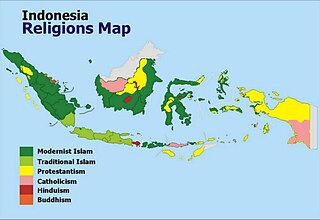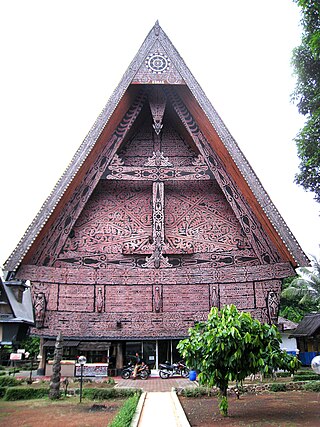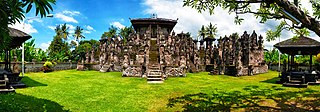
Garuda is a Hindu deity who is primarily depicted as the mount (vahana) of the Hindu god Vishnu. This divine creature is mentioned in the Hindu, Buddhist and Jain faiths. Garuda is also the half-brother of the Devas, Gandharvas, Daityas, Danavas, Nāgas, Vanara and Yakshas. He is the son of the sage Kashyapa and Vinata. He is the younger brother of Aruna, the charioteer of the Sun. Garuda is mentioned in several other texts such as the Puranas and the Vedas.

The culture of Indonesia has been shaped by long interaction between original indigenous customs and multiple foreign influences. Indonesia is centrally-located along ancient trading routes between the Far East, South Asia and the Middle East, resulting in many cultural practices being strongly influenced by a multitude of religions, including Buddhism, Christianity, Confucianism, Hinduism, and Islam, all strong in the major trading cities. The result is a complex cultural mixture, often different from the original indigenous cultures.

Batak is a collective term used to identify a number of closely related Austronesian ethnic groups predominantly found in North Sumatra, Indonesia, who speak Batak languages. The term is used to include the Karo, Pakpak, Simalungun, Toba, Angkola, and Mandailing, related ethnic groups with distinct languages and traditional customs (adat).

Hinduism is the third-largest religion in Indonesia, based on civil registration data in 2022 from Ministry of Home Affairs, is practised by about 1.69% of the total population, and almost 87% of the population in Bali. Hinduism was the dominant religion in the country before the arrival of Islam and is one of the six official religions of Indonesia today. Hinduism came to Indonesia in the 1st-century through Indian traders, sailors, scholars and priests. A syncretic fusion of pre-existing Javanese folk religion, culture and Hindu ideas, that from the 6th-century also synthesized Buddhist ideas as well, evolved as the Indonesian version of Hinduism. These ideas continued to develop during the Srivijaya and Majapahit empires. About 1400 CE, these kingdoms were introduced to Islam from coast-based Muslim traders, and thereafter Hinduism, which was previously the dominant religion in the region, mostly vanished from many of the islands of Indonesia.

Makara is a legendary sea-creature in Hindu mythology. In Hindu astrology, Makara is equivalent to the Zodiac sign Capricorn.

Several different religions are practised in Indonesia. Indonesia is officially a presidential republic and a unitary state without an established state religion. Indonesia has the world's largest Muslim population and the first principle of Indonesia's philosophical foundation, Pancasila, requires its citizens to state the belief in "the one and almighty God". Although, as explained by the Constitutional Court, this first sila of Pancasila is an explicit recognition of divine substances and meant as a principle on how to live together in a religiously diverse society. However, blasphemy is a punishable offence and the Indonesian government has a discriminatory attitude towards its numerous tribal religions, atheist and agnostic citizens. In addition, the Aceh province officially applies Sharia law and is notorious for its discriminatory practices towards religious and sexual minorities. There are also Islamic fundamentalist movements in several parts of the country with overwhelming Muslim majorities.

The architecture of Indonesia reflects the diversity of cultural, historical, and geographic influences that have shaped Indonesia as a whole. Invaders, colonizers, missionaries, merchants, and traders brought cultural changes that had a profound effect on building styles and techniques.

A candi is a Hindu or Buddhist temple in Indonesia, mostly built during the Zaman Hindu-Buddha or "Hindu-Buddhist period" between circa the 4th and 15th centuries.
A tunggal panaluan is a magic staff used by shamans of the Batak people, who live in the highlands of North Sumatra, Indonesia. Traditionally the tunggal panaluan is made from wood of a specific tree and carved with human figures and embellished with horsehair and cooked human brain, both procured from sacrificial victims.

A Dvarapala or Dvarapalaka is a door or gate guardian often portrayed as a warrior or fearsome giant, usually armed with a weapon - the most common being the gada (mace). The dvarapala statue is a widespread architectural element throughout Hindu, Buddhist, and Jaina cultures, as well as in areas influenced by them like Java.

Patuan Bosar SinambelaginoarOmpu Pulo Batu, better known as Si Singamangaraja XII, was the last priest-king of the Batak peoples of north Sumatra. In the course of fighting a lengthy guerrilla war against the Dutch colonisation of Sumatra from 1878 onwards, he was killed in a skirmish with Dutch troops in 1907. He was declared a National Hero of Indonesia in 1961 for his resistance to Dutch colonialism.

The mythology of Indonesia is very diverse, the Indonesian people consisting of hundreds of ethnic groups, each with their own myths and legends that explain the origin of their people, the tales of their ancestors and the demons or deities in their belief systems. The tendency to syncretize by overlying older traditions with newer foreign ideas has occurred. For example, the older ancestral mythology might be merged with foreign mythology, such as Hindu, Islam, or Christian biblical mythology.

Boraspati ni Tano or Boraspati, also known as Ilik, is the earth deity in Batak mythology. Boraspati ni Tano is represented as a tokay gecko. Images of Boraspati can be found decorating the door of a Batak Karo and Batak Toba buildings as well as other Batak objects e.g. the cover of the pustaha or the pupuk container naga morsarang.

The Great Pustaha is a pustaha displayed in the Tropenmuseum of Amsterdam. The name refers to the largest pustaha which was kept in the museum. The official name for the pustaha is simply "pustaha", but for the purpose of distinction, the pustaha is called the Great Pustaha.

Gorga is a form of artistic decoration found in the culture of Batak Toba in North Sumatra, Indonesia. The gorga motif is in the shape of flourishes and undulations. The motif is either painted or carved onto wood using three colors: white, red, black; each corresponds with different realms in the Batak Toba cosmology. Gorga motif is often found in Batak Toba architecture e.g. a Batak Toba house or objects e.g. music instruments. They are meant to protect the building or object from spiritual harm e.g. evil spirits sent from neighboring village.

The naga morsarang, also known as sahan, is a container which is used to store medicine in the culture of Toba Batak people of North Sumatra, Indonesia. The naga morsarang is created out of the horn of the water buffalo.

In a Balinese temple architecture, a Bhoma is a carved or formed grotesque which decorates certain parts in the Balinese temple complex. The statue is similar to the Javanese Kala, and was intended to protect the temple complex from malevolent spirits.

Pura Beji Sangsit is a Balinese temple or pura located in Sangsit, Buleleng, on the island of Bali, Indonesia. The village of Sangsit is located around 8 kilometres (5.0 mi) east of Singaraja. Pura Beji is dedicated to the rice goddess Dewi Sri, and is revered especially by the farmers around the area. Pura Beji is an example of a stereotypical northern Balinese architecture with its relatively heavier decorations than it is southern Balinese counterpart, and its typical foliage-like carvings.

Barong dance is a style of traditional Balinese from Bali, Indonesia. The dance demonstrates about the mythological depiction of animals that have supernatural powers and the ability to protect humans. Barong is the king of the spirits, leader of the hosts of good, and the enemy of Rangda, the demon queen and mother of all spirit guarders in the mythological traditions of Bali. The Barong dance featured a battle between Barong and Rangda to represent the eternal battle between good and evil.



















